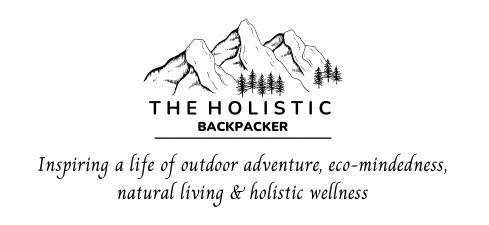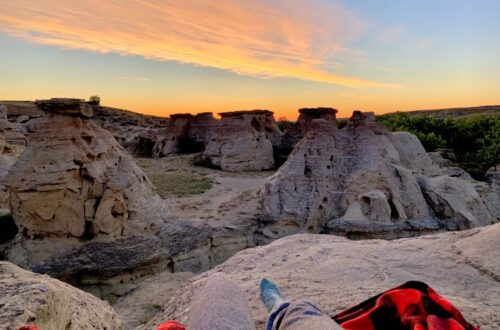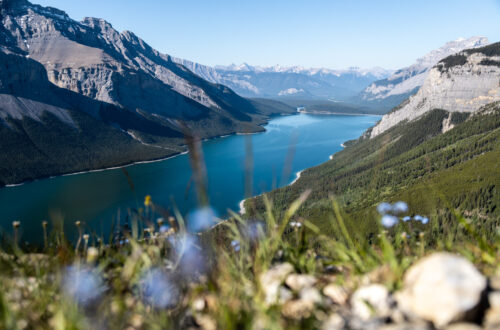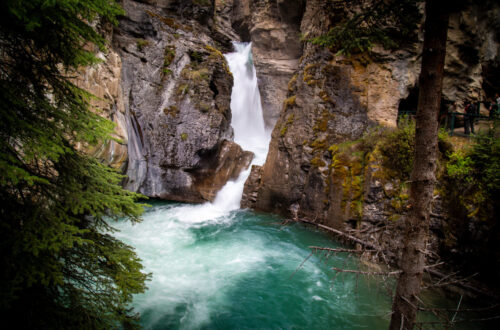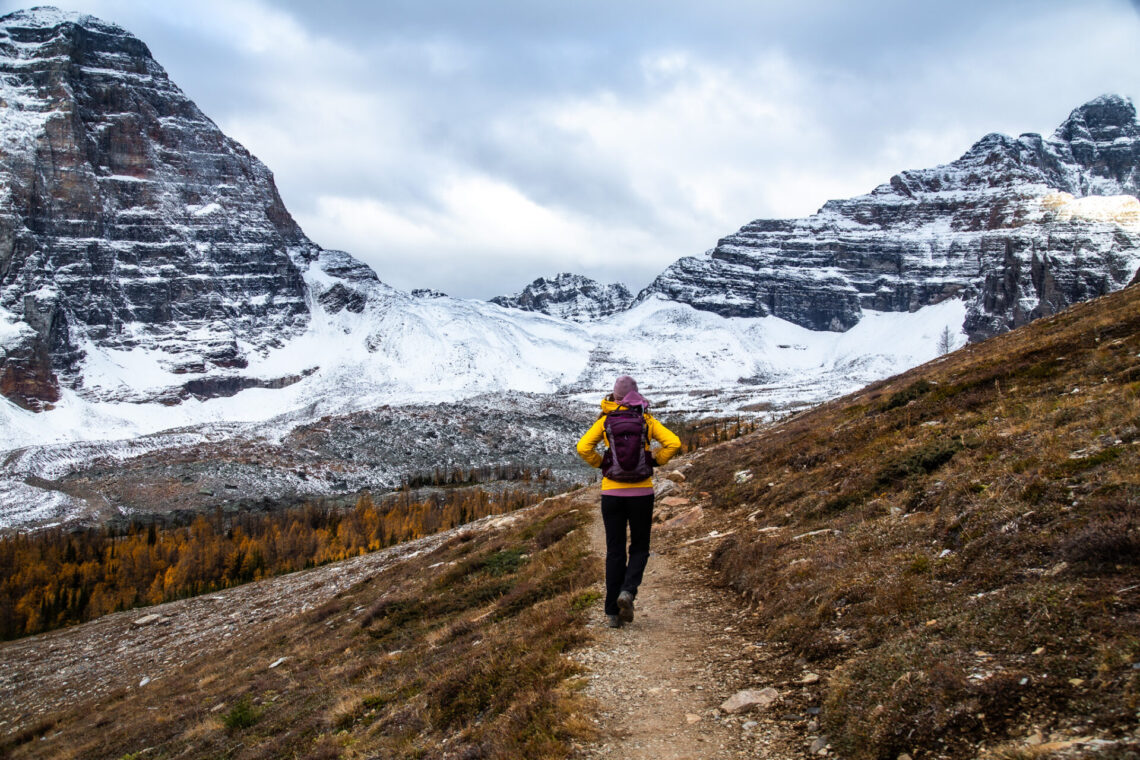
What to Wear Hiking in Banff & the Canadian Rockies
In this post I’ll tell you everything you need to know about what to wear hiking in Banff, plus give you tips for what to wear hiking in Banff in winter. Banff is a popular destination for hiking and outdoor adventure, but the high elevation and colder temperatures can be a bit nerve-wracking for new hikers. In this post I’ll alleviate any remaining questions you have regarding what to wear in Banff and how to dress to stay warm.
Banff has a short hiking “season,” however hikes remain open year round – you just have to know what to wear. I’ll give you one tip that always helps me decide what to wear – dress in layers. This is the key to choosing the most successful and versatile attire for your Banff adventures.
Skip ahead:
- Hiking Season in Banff + Weather
- Safety Tips for Hiking in Banff
- Banff Hiking Essentials: Gear Guide
- Best Footwear for Hiking in Banff
- Best Backpack for Hiking in Banff
- #1 Tip – Dress in Layers
- Best Jackets for Hiking in Banff
- Banff Hiking Accessories
- What to Wear Hiking in Banff: Backcountry Camping
- What to Wear Hiking in Banff in Winter
As you read this post, please consider clicking the links throughout. These are affiliate links which means when you book a hotel or purchase a product, I make a small commission at no additional cost to you (full disclosure). These commissions fund The Holistic Backpacker and help me write more blog posts.
Thank you for supporting my work!
Banff Google Map: 600+ Pins
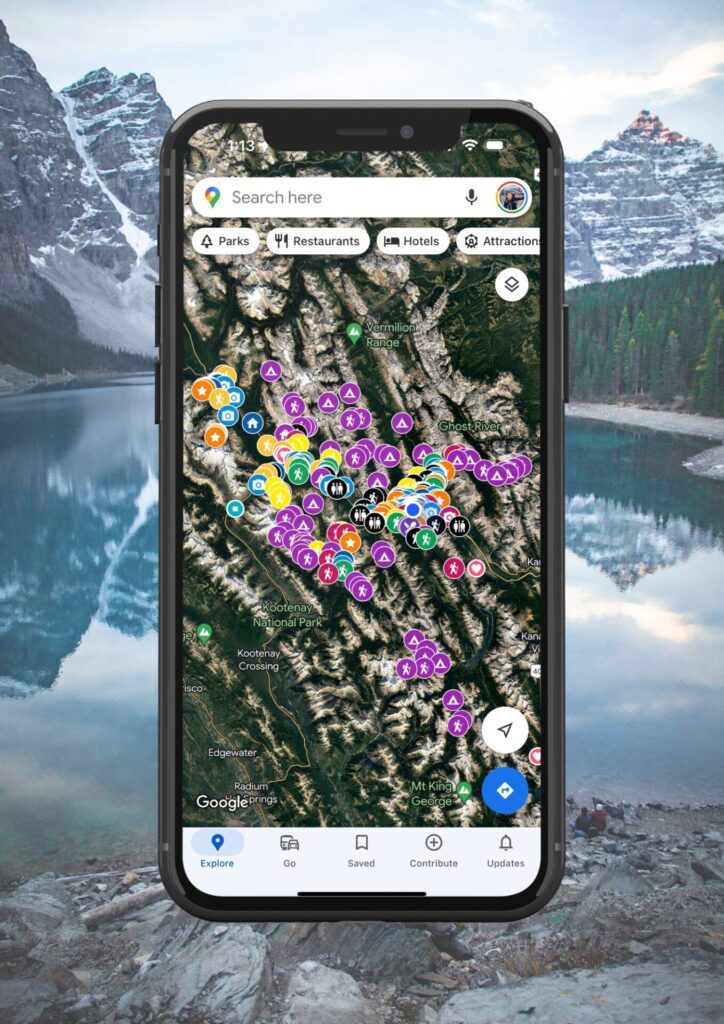
Get my 600+ Banff recommendations saved to your Google Maps app
Outdoors: 100+ hiking trails, backcountry campgrounds, ski resorts, waterfalls & lakes
Planning: lodging, restaurants, public washrooms & transit hubs
Things to do: tours, viewpoints & unique activities
I lived in Banff for years and know all the best spots!
Hiking Season in Banff + Weather
Banff’s summer season is short which means the “true” hiking season falls within a brief window.

May to September marks Banff’s official hiking season, however this is a loose timeframe. There are trails suitable for year round hiking, whereas some higher summits are only accessible during a small window from about mid July to mid August. The snow on lower elevation hikes typically melts toward the end of April and doesn’t gather until late October which means these hikes are doable for a much longer period.
Avalanche danger is a real threat in the Canadian Rockies and is possible whenever there’s snow at higher (and lower) elevations on the mountains. This means that low elevation hikes may still have snow above making them unsafe in spring or fall. You can see local trail reports here.
I love this website for weather forecasts in Banff. I find it’s usually quite accurate for temperature and cloud coverage, however in my experience it often under predicts precipitation. If I’m trying to get a better idea of avalanche danger I use that site in combination with Caltopo, plus look at both the Google Maps and Alltrails satellite view to survey terrain.
Keep in mind the higher you hike, the colder it will be. Oftentimes Banff will experience warm weather at the town’s elevation, but nearby summit temperatures will be freezing. Always bring extra layers.
Here are posts for my
Connect via socials:
Sign up for emails to receive a 25% discount on my travel maps.
Taylor ♡
Safety Tips for Hiking in Banff
Banff is an active hiking destination which means you’ll likely be out in the mountains during your trip. Here’s some tips to keep you safe.
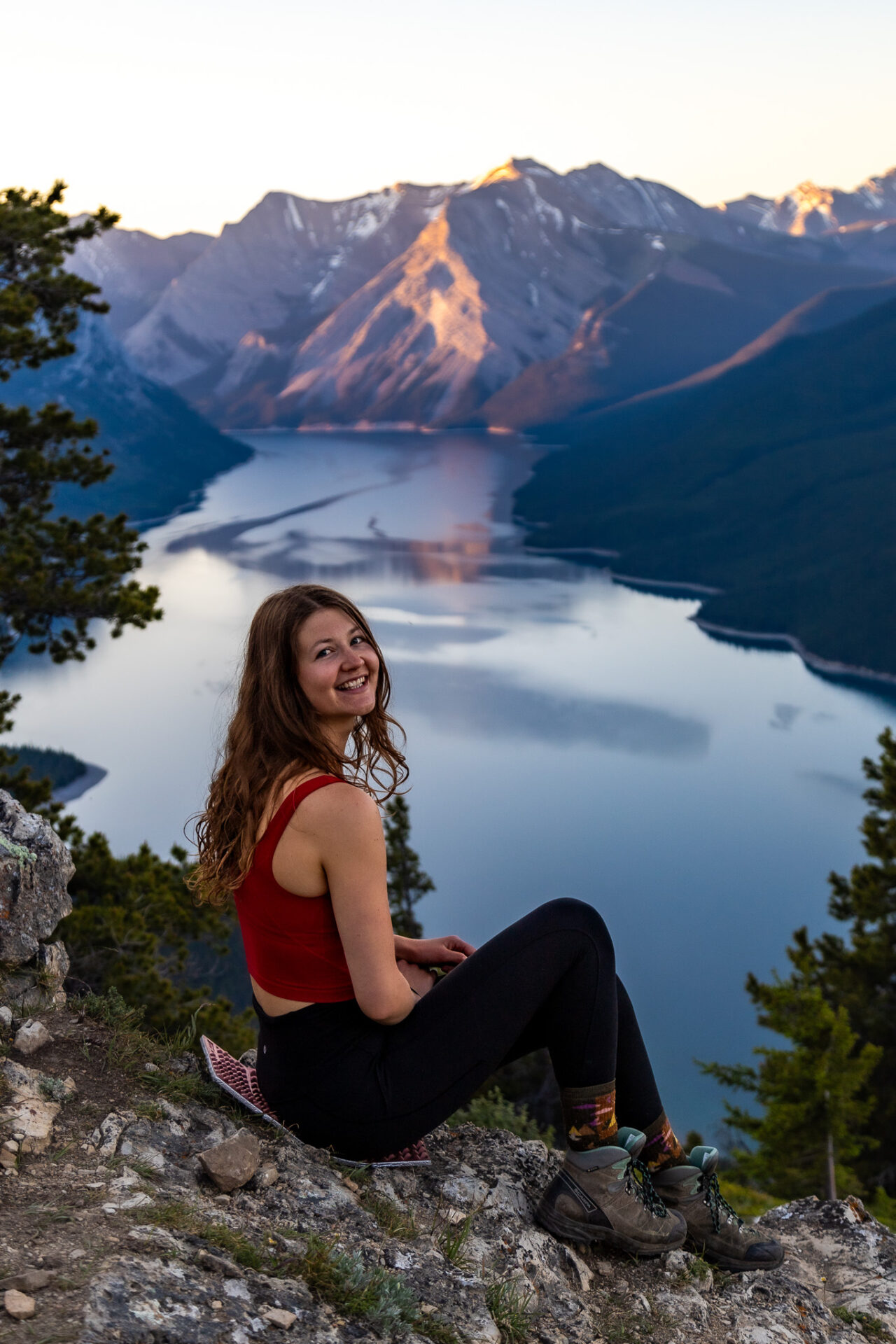
Wildlife: bears, cougars, and a plethora of other wildlife calls Banff home. It’s essential you carry bear spray and know how to use it. Travelling in groups, hiking within daylight hours, and making noise on the trail greatly reduces your chance of a bear encounter.
Satellite Communication Device: many of Banff’s trails wander quite far from “civilization.” It’s always good to carry a device like the Garmin Inreach Mini 2 in case an accident happens. I never hit the trail without my Garmin. Travellers can also purchase Garmin’s Search & Rescue Insurance which covers helicopter rescues – no travel insurance company covers this.
Ticks: are a growing issue in North America, especially in the spring months. It’s always a good idea to carry a tick removal tool.
Download Maps: I’m not too savvy when it comes to paper maps, so I purchase the Alltrails membership every year. This allows me to download offline maps/hiking routes and track my location via satellite when I’m not connected. I always bring a portable charger for longer hikes to ensure my phone doesn’t die.
More Safety Tips: make sure you have lots of daylight, tell someone where you’re going/when you return, carry extra snacks and have the ability to filter water – this Aquatab + cheese cloth combo is a lightweight, efficient filtering option. Bringing sun protection is also a wise idea.
More Safety Devices: whistle, first aid kit, emergency bivy, and blister pads.
Banff Hiking Essentials: Gear Guide
In addition to what to wear hiking in Banff I’ll also go over a few gear items that may be helpful. Keep in mind you don’t need to buy new gear for Banff. But certain items make hiking in Banff more convenient and comfortable.

Water Bladder: I’ve used this bladder on every hike for years and I’ve never had issues with leaking or punctures. A bladder provides a very convenient way to stay hydrated while hiking. I also always carry this filter or these tabs + cheese cloth which give me the ability to filter water on-the-go if needed.
- Tip – add Celtic salt to your water bladder for electrolytes. Celtic salt leaves no taste in the bladder
Hiking Poles: help with stability and slippery terrain, reduce knee impact, and give your arms something to do. They make hiking a full body workout – otherwise my arms literally get bored! I use this foldable pair for travelling, otherwise I purchase the cheapest pair locally.
Capture Clip: the best invention for photographers. This handy clip allows you to keep your camera strapped safely to the exterior of your pack straps. No more taking off your backpack to grab your camera or awkwardly carrying it around your neck or shoulder.
Other Things to Pack: toilet paper, Stasher bags to pack snacks in, chapstick, extra hairbands, gloves, a hat, and an extra layer.
My complete Banff gear guides can be found here
How to Find Hiking Trails in Banff
One more thing before I tell you about what to wear hiking in Banff. This is especially helpful for Banff newcomers – how to find hikes in Banff?
Canada and the USA use a platform called Alltrails for hikes. This has the majority of hikes in the area listed with stats, photos, and reviews from other hikers. If you purchase their membership you can download offline maps and see your live location via satellite. I purchase this membership each year.
I’ve also put this Banff & Lake Louise map together which outlines every named trail, backcountry route + many unnamed trails in the park. It totals well over 100 trails and holds my personal trail descriptions, photos, links, and more.
Banff Google Map: 600+ Pins

Get my 600+ Banff recommendations saved to your Google Maps app
Outdoors: 100+ hiking trails, backcountry campgrounds, ski resorts, waterfalls & lakes
Planning: lodging, restaurants, public washrooms & transit hubs
Things to do: tours, viewpoints & unique activities
I lived in Banff for years and know all the best spots!
Best Footwear for Hiking in Banff
What to wear hiking in Banff starts with a good pair of shoes as this will make or break your experience.
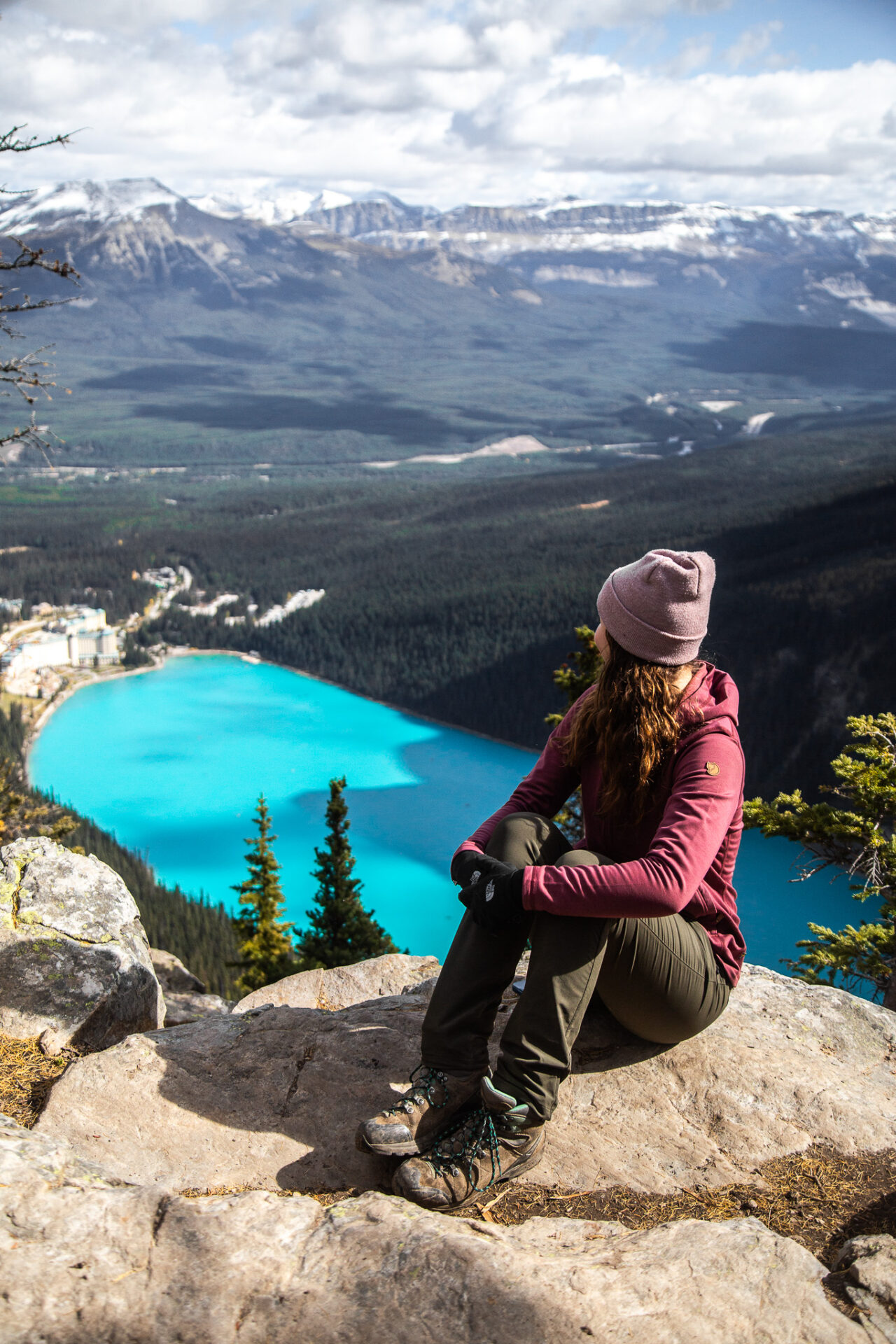
The best footwear for Banff comes down to personal preference and what you plan to hike. Lower elevation trails typically require no more than running shoes, although I always recommend trail runners at the absolute minimum. Trail runners are sturdier than the average running shoe, they have better grip, they’re are designed to handle elevation changes, and are better suited to non-pavement surfaces.
For backpacking trips, higher elevation hikes through rocky terrain, or longer days I always recommend a hiking boot – unless you’re running the terrain. In this case stick to a trail runner.
What to look for in a hiking boot – sturdy, Goretex, comfortable, ankle support, built to last.
From my personal experience, these are the best footwear choices for hiking in Banff:
Scarpa Kailesh
This is my trusty hiking boot. I’ve had it for years, used them on all types of terrain, and in temperatures from -30 to +36.
Salomon Speedcross
Lightweight, huge traction, and designed to tear up mountain terrain.
Best Socks for Hiking in Banff
I only use Smartwool socks for hiking in Banff. They’re wool, last for ages, and come in various patterns, styles, and cushion. I prefer crew length with full cushion.
They also dont get stinky right away so you don’t have to wash them as often. They’re my go-to for international travel as well as hiking.
You can purchase Smartwool socks in both Canada and the USA.
Best Backpack for Hiking in Banff
The best backpack for hiking in Banff depends on what types of trails you’re hitting. If you’re only visiting Banff for a short time the backpack you have lying around at home will do. If you plan to hike in Banff for longer, purchasing a pack with technical features may be beneficial for you.

What to look for in a good backpack: hip belt, chest strap, hydration reservoir, external frame or back vents, external straps, lots of zippered pockets.
These are the best backpacks for hiking in Banff – from my own experience:
Osprey Sirrus 24L: the Sirrus 24L currently is and has been my go-to day pack for hiking in Banff for years. It’s full of technical features, small but roomy, and has tons of pockets and storage space. It also has external straps for footwear, a hydration reservoir, and an included rain cover that come standard with the pack. The 24L Stratos is the men’s version of the Sirrus.
Osprey Sirrus 36L: I love the Sirrus 24L so much I purchased the Sirrus 36L too. The 36L is more roomy, has a top lid, more external straps, and larger waist belt pockets. I love this bag for light overnighters and it’s the perfect size for carry-on travel. The men’s version of this bag is the Stratos 36L.
Osprey Aura AG 65L: the Aura 65L is what I use for backcountry camping. It’s the preferred backpack for thruhikers and those tackling the PCT for its crazy range of features and its antigravity suspension system which takes your pack’s weight off your shoulders. You can also detach the top lid to make the pack smaller. The men’s version of this bag is the Atmos 65L.
Rain Cover: If your backpack doesn’t come with a built-in rain cover I recommend buying one to keep your pack’s content’s dry and to keep your pack cleaner in muddy areas. These pack covers come in a variety of sizes and colours, plus they’re a great price.
What to Wear Hiking in Banff + Dressing in Layers
The most helpful tip I can give you when it comes to what to wear hiking in Banff is to dress in layers. Between quick changing weather, elevation gain, and varying temperatures at altitude you’ll likely constantly need to change your attire as you go.
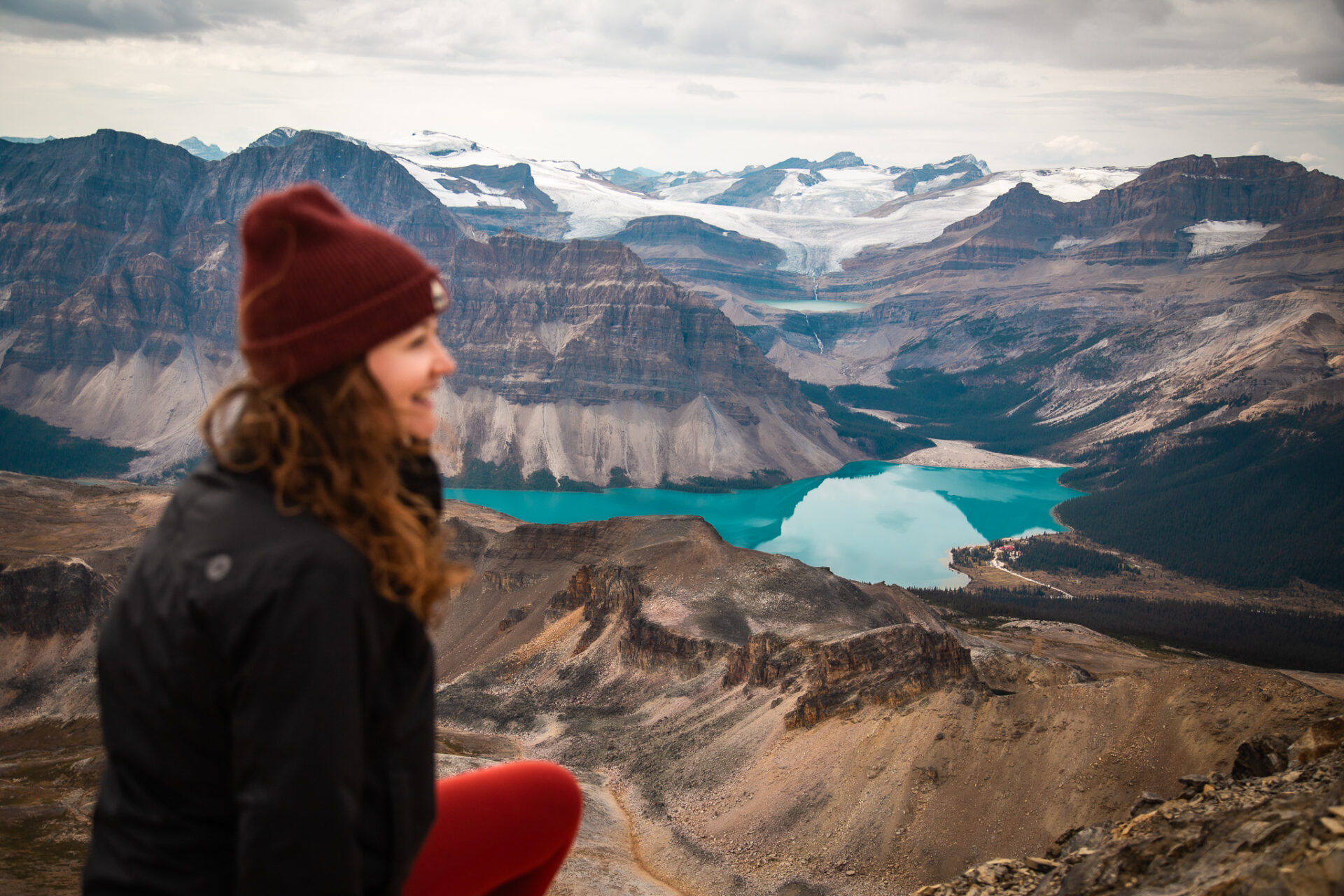
Wear the right materials. I recommend no other than wool for base layers. On most hikes my shirt choice is a long sleeve wool/synthetic blend from Fjallraven or Kari Traa – my two favourite base layer companies. Underneath I may have a cute tank top for taking summit pictures, but often it’s too cold for this and I end up layering up rather than layering down.
If you’re wondering what I personally wear in Banff for hiking, it’s almost always a long sleeve shirt and pants – even in summer. Unless it’s 100% guaranteed hot or I’m on a quick trail I’m typically always in longer layers to minimize sun exposure (sans-sunscreen) and to prevent my skin from inevitably being scratched up by bush and rock.
I prefer hiking pants over leggings as they have more pockets and the material of hiking pants is better for sweating and more durable to withstand Banff’s rocky terrain.
- ps – I always look for hiking pants with a built in belt to easily adjust sizing and with the little pocket mid thigh so I can easily store and access my phone while hiking
Shorts vs pants? I’ll occasionally wear shorts hiking in banff in peak summer or on low elevation hikes, but if I’m gaining any noticeable elevation I’ll pack a pair of pants in case it gets cold. Or I’ll wear them underneath my pants if I want to easily change mid hike. Oftentimes the summit is cold and windy meaning your shorts may not cut it.
I also always bring a jacket or two no matter the weather or season. My jacket recommendations can be found be below.
Best Jackets for Hiking in Banff
If you’re planning what to wear hiking in Banff, add a few jackets to your list. Even in you visit Banff in summer, higher elevation hikes will usually always be cold. This means you’ll have to pack and maybe even wear more on your Banff hikes.
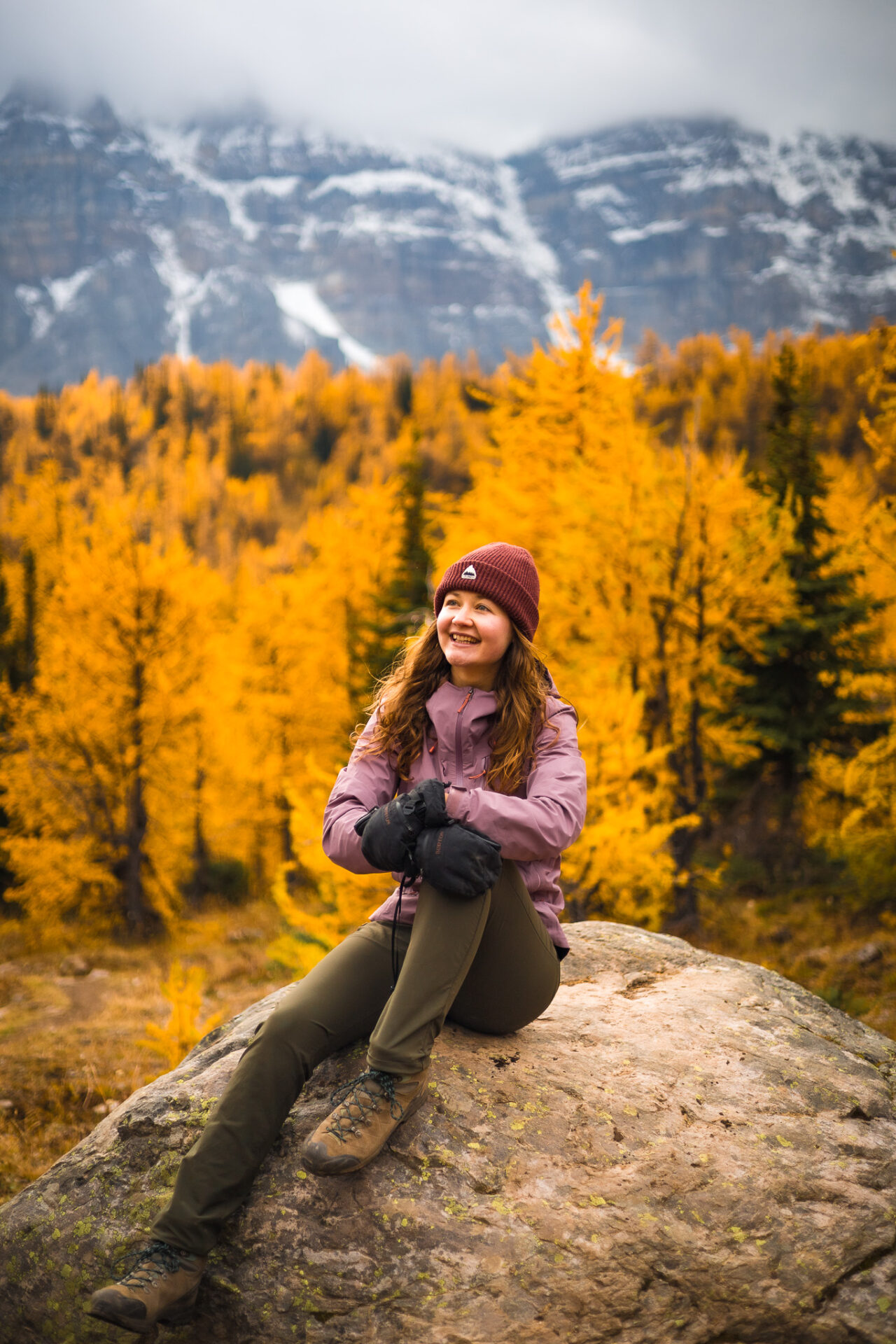
Patagonia is my go-to brand for hiking jackets suitable for Banff’s climate. I use their down jackets, rain jackets, technical jackets, and more. I find their style vs quality vs cost is great compared to many other brands.
Down Jackets
A down jacket is one of the most useful pieces of clothing for hiking in Banff. They’re lightweight, super warm, and are often designed to fold down into their own pocket meaning they take up minimal space in your pack. I bring a down jacket with me on every hike in Banff just in case.
My favourite down jacket is from Patagonia – it comes in both a hoodless (which I love) and hooded style. I have it in 2 colours, I wear it all the time hiking in Banff, plus I bring it on international backpacking trips.
Patagonia down jacket links for Canadian readers: women’s sizing | men’s sizing
Patagonia down jacket links for USA readers: women’s sizing | men’s sizing
Rain Jacket & Pants
A rain jacket is a good option to wear hiking in Banff because, like a down jacket, it’s lightweight and folds up small in your pack. A rain jacket is a great clothing item for hiking in Banff as it helps keep the wind and rain off you while simultaneously keeping your body heat in.
The rain jacket linked below is what I wear on Banff hikes that are cold but not cold enough to wear a down jacket or a mid layer. The jacket is flattering, comes in fun colours, and doesn’t make the “swoosh” sound when you move.
Patagonia rain jacket for Canadian readers: women’s sizing | men’s sizing
Patagonia rain jacket for USA readers: women’s sizing | men’s sizing
I also wear rain pants hiking in Banff when it rains or if the terrain is wet/muddy and there’s a chance of slipping. I use the Patagonia rain pants that match the jacket above. They also fold up small and don’t make the “swoosh” sound which is uncommon for rain pants.
Patagonia rain pants for Canadian readers: women’s sizing | men’s sizing
Patagonia rain pants for USA readers: women’s sizing | men’s sizing
Technical Jackets
Oftentimes for steep hikes in cold weather when I’m breaking a heavy sweat I’ll wear a technical jacket which is defined as a high-performance, weatherproof garment designed to protect the wearer from the elements and keep them comfortable and dry in a variety of conditions.
My favourite technical jacket to wear hiking in Banff is this one:
Technical jacket for Canadian readers: women’s sizing | men’s sizing
Technical jacket for USA readers: women’s sizing | men’s sizing
Mid Layer
And finally, a mid layer is something I’ll wear hiking in Banff for in-between or cooler weather when a jacket is too much, but a shirt is too little. I typically choose a mid layer made with wool or a synthetic/wool blend. Usually I wear a tank top or short sleeve underneath the mid layer, but also bring a long sleeve if I want to switch out the mid layer for a down jacket or rain jacket + long sleeve combo later.
I usually always buy my mid layers to wear hiking in Banff from Fjallraven. They have an online store, but sometimes their sizing can vary. There’s a physical Fjallraven store in the town of Banff where you can try things on.
Banff Hiking Accessories
Along with clothing to wear hiking in Banff, there’s also handful of accessories I never hit the trail without.

Hat: I typically always toss a hat in my pack no matter the season. In winter I rotate between a toque and a wool headband like this. In summer I rotate between a visor and this versatile bucket hat (USA link).
Sunglasses: I wear the Oakley Sutros (smaller size for women). I own 3 pairs of these glasses and absolutely love them. They block out light from all directions, don’t get sweaty, and they completely prevent wind and dust from reaching my eyes.
Gloves: I always pack a thin pair of gloves (even in summer) for cold temperatures or unexpected scrambling so my hands don’t get cut up. I like these gloves (men’s sizing). If I know the hike involves scrambling and handholds I bring gloves like these which are more durable.
Headlamp: I always pack a headlamp for sunrise/sunset hikes or times when I’m not sure I’ll make it back to the car during daylight hours. I’ve been using this headlamp for hiking, camping, and travelling for years. It’s one of the best, most reliable headlamps on the market. Plus it’s rechargeable.
Satellite Device: I’m mentioning this satellite device again as it’s paramount to safety when it comes to hiking in the Canadian Rockies – especially if you’re tackling challenging terrain or venturing into the backcountry. I never hit the trail with out my satellite device.
What to Wear Hiking in Banff: Backcountry Camping
I’ve linked all my individual favourite items for what to wear hiking in Banff above, so here I’ll simply list the non-negotiable clothing items I wear hiking in Banff for backcountry camping trips.
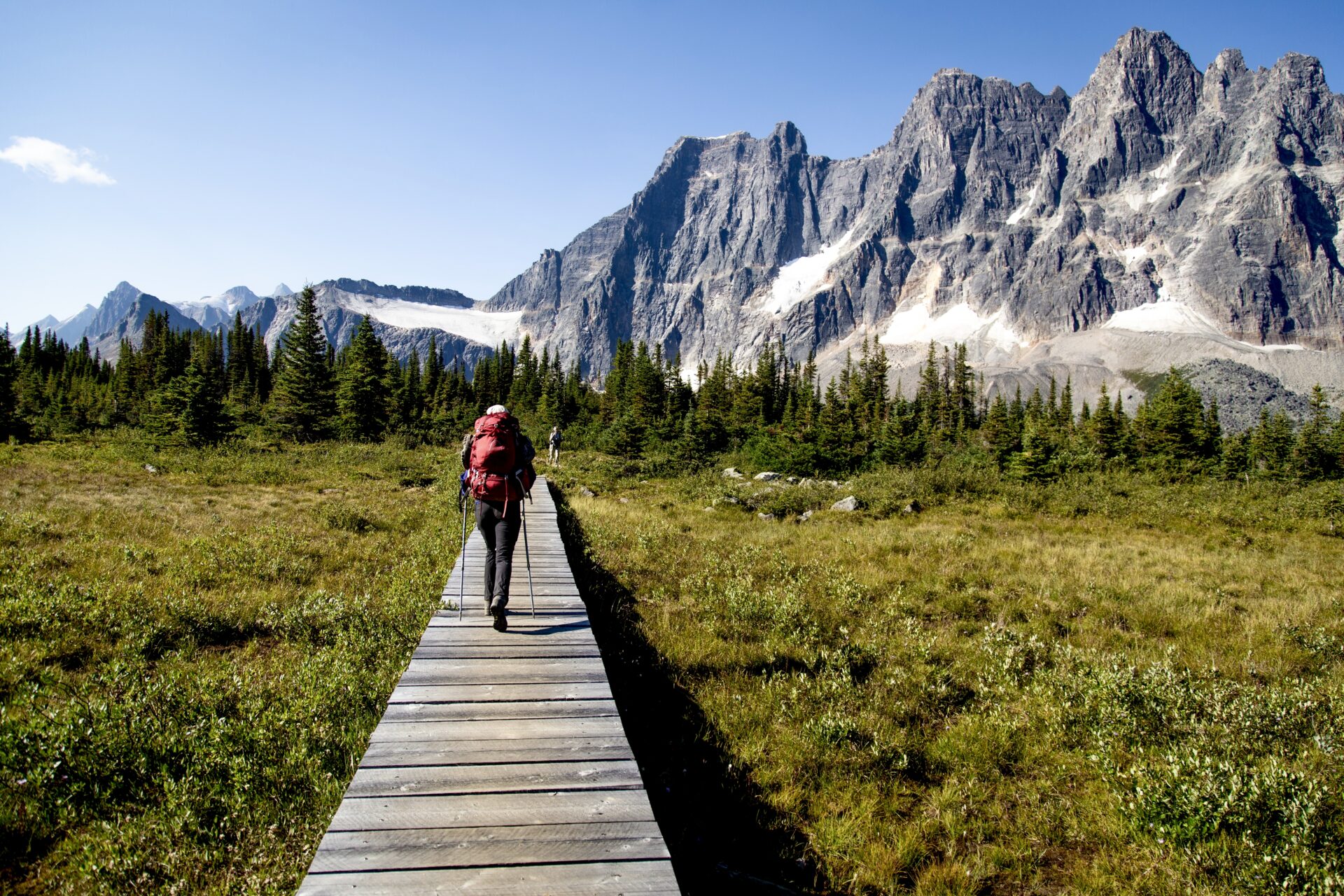
For sleeping: 1 set of high quality wool base layers, these -40 socks, and a toque.
Clothing: hiking pants, long sleeve wool shirt, extra pair of underwear, extra pair of hiking socks, a hat, and potentially an extra wool tank top or sports bra depending on trip length.
Jackets: waterproof jacket and pants, down jacket, and potentially a mid layer depending on expected temperatures. Scroll back to my jacket recommendations.
Other: bathing suit top for swimming (use underwear for bottoms) and on the rare occasion I’ll bring an extra clothing item if I have a “vision” for a specific picture.
What to Wear Hiking in Banff in Winter
What to wear hiking in Banff in winter varies from what to wear hiking in Banff in summer. Temperatures are colder, snow is a factor, and extra traction is required.
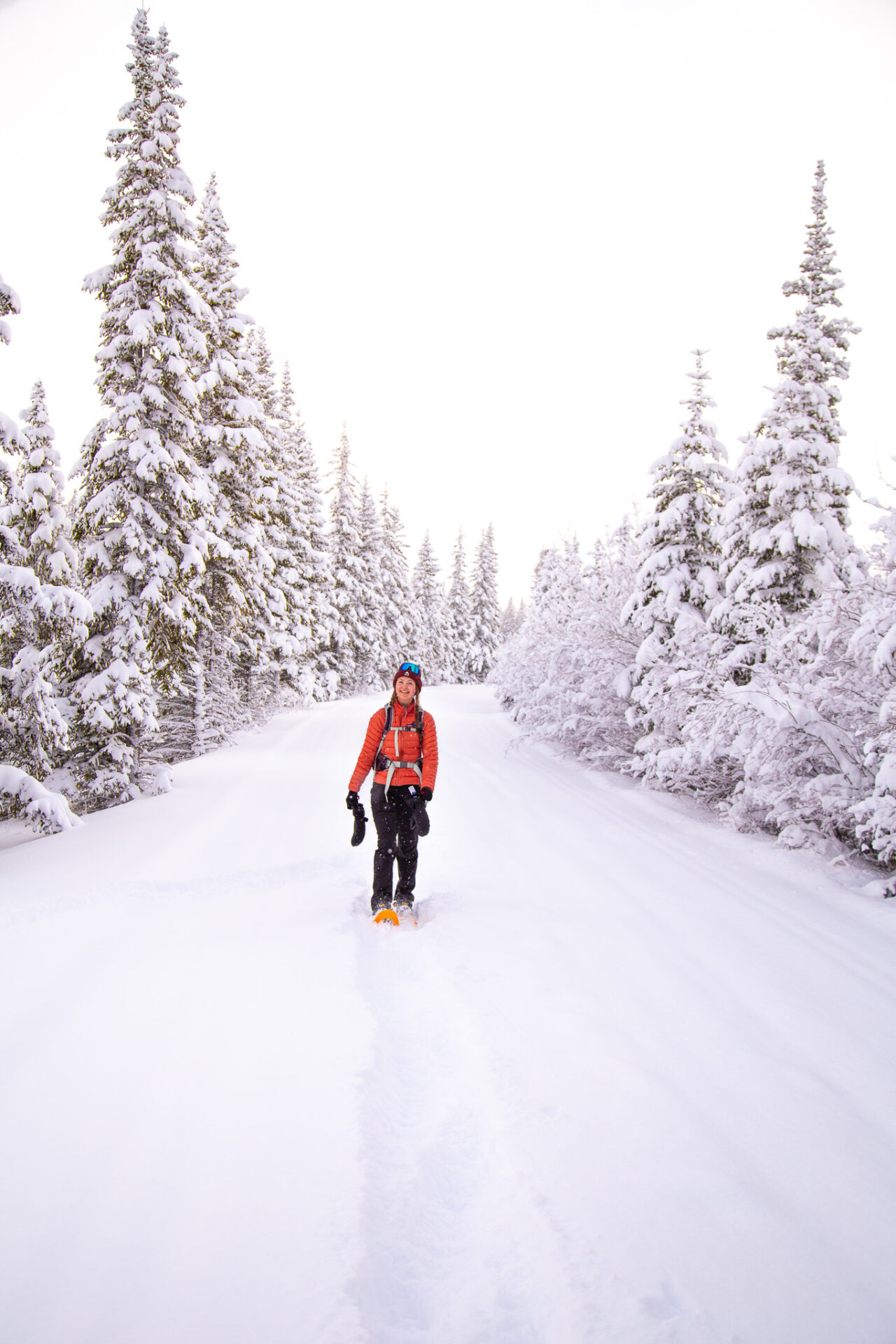
Here are some of my relevant Banff winter guides
What to Wear Hiking in Banff in Winter
Pants: I wear soft-shell pants for hiking in Banff in winter. They’re water resistant, thicker, and usually have a fine fleece or wool layer on the inside for extra insulation. I love this pair from MEC (men’s sizing). If you’re reading from the USA you can find a similar style from REI (men’s sizing).
Jacket: I have my favourite jackets linked above. I rotate between down jackets, waterproof jackets, technical jackets, and mid layers depending on the hike’s elevation gain, terrain (open space vs trees), and the expected temperature. I usually bring all three types of jackets on every winter hike just in case.
Base layers: I stick with wool base layers – same as summer. But I only wear base layers on my upper body. Wearing any base layers under soft-shell pants makes me feel claustrophobic as there’s too much resistance with the materials rubbing together.
Gloves: I always pack every pair mentioned here, but I rotate between wearing these gloves on warmer days (men’s sizing) and these ultra warm mittens for very cold days. I always wear a pair of wool glove liners underneath the mittens in case I need to take the gloves off for a few minutes and to keep the gloves cleaner.
- The thick gloves I mentioned above are quite pricey, but I’ve used this pair (men’s sizing) as well which are less expensive, but still very warm
Hat: I wear a wool headband while I’m actively hiking. I also bring a toque for when I stop or for the downhill when I’m not working up as much of a sweat.
Gear Required for Hiking in Banff in Winter
In addition to the clothing to wear hiking in Banff in winter, there’s also a few gear related items that’ll make your hiking trip much easier and enjoyable. I bring the following with me on winter hikes in Banff:
Crampons: come with me on every hike – if there’s snow I’m wearing them to help with traction. I use this pair which I love. They’re durable and come in at a great price point.
Snowshoes: I use these which are the best pair I’ve seen on the market, but they’re quite expensive. Instead you may want to consider this more cost effective pair from the same company which still hold exceptional quality. If you only snowshoe the odd time, this snowshoe kit is a great option for most.
Hiking Poles: any pair of hiking poles will do, just be sure they have wide baskets at the end. I usually buy a cheap pair locally or use these travel size hiking poles (I travel with these all over the world).
Foot & Hand Warmers: I have reusable hand and foot warmers made of beaver pelts from Aurora Heat – a Yukon based company run by Indigenous women. They are the most effective warmers I’ve used and they’re eco-friendly.
ps – you can rent Crampons and snowshoes from the town of Banff at Bactrax if you don’t own a pair
Banff Google Map: 600+ Pins

Get my 600+ Banff recommendations saved to your Google Maps app
Outdoors: 100+ hiking trails, backcountry campgrounds, ski resorts, waterfalls & lakes
Planning: lodging, restaurants, public washrooms & transit hubs
Things to do: tours, viewpoints & unique activities
I lived in Banff for years and know all the best spots!
My Featured Banff Blogs
Travel Guides
Banff Activities
Quick Banff Guide
First time visiting Canada? This page outlines all my travel tips for those new to Canada.
When to visit: this post breaks down each month in Banff with average temperatures and corresponding activities.
How to get to Banff: fly into Calgary International Airport. From here, rent a car (what I recommend), RV, or take one of the following shuttles to Banff:
- Budget: On-It runs during the summer months and Pop-a-Ride is a ride-share program. You can use my Poparide link to save $5 on your first trip.
- Professional shuttles: Banff Airporter and Brewster.
- Car rental: having access to a car is the best way to travel to/from/within Banff. This site compares the best local rates.
Best Activities in Banff: here are all my recommendations for the best tours, activities, and unique experiences in Banff & beyond.
Moraine Lake or Lake Louise: read my guide for how to get there with the new road closures. If you want to see Moraine Lake at sunrise, you can book a shuttle here.
Lodging & Camping: Here’s my guide for hotels in Banff (Organized by Category). If you’re visiting during peak summer (mid June to early September), make your lodging reservations FAR in advance. Front country and backcountry camping reservations must be made on the Parks Canada reservation system. The system typically opens in January and it’s recommended you make reservations then.
Reservations: for activities and restaurants should be made well in advance during summer. Get Your Guide and Viator are popular tour booking platforms whereas OpenTable is used for restaurants.
Parks Pass: You’ll need a National Park Pass for your vehicle for each day you’re in Banff. Passes can be purchased at the East Parks Gates, the Visitor Centre, or online. If you’ll be in any of Canada’s National Parks for more than 7 days in a 365 day period, an annual Discovery Pass offers a better rate than purchasing individual day passes.
Roam Transit: once you arrive in Banff, use the local transit service as much as possible to avoid parking issues. There are bus lines within town, plus lines to popular spots like Lake Louise and Johnston Canyon. The bus to Lake Louise should be reserved in advance.
Parking: the best spot to park is the free lot next to the train station. More information about parking in town can be found here and parking fees can be paid here. Bylaw is strict, so ensure you’re following parking rules exactly.
Wildlife Safety: 11 ways to stay safe from wildlife, bear safety, & bear basics.
Happy adventuring!
Taylor ♡
Like This Post?
Share with friends or save it for later!
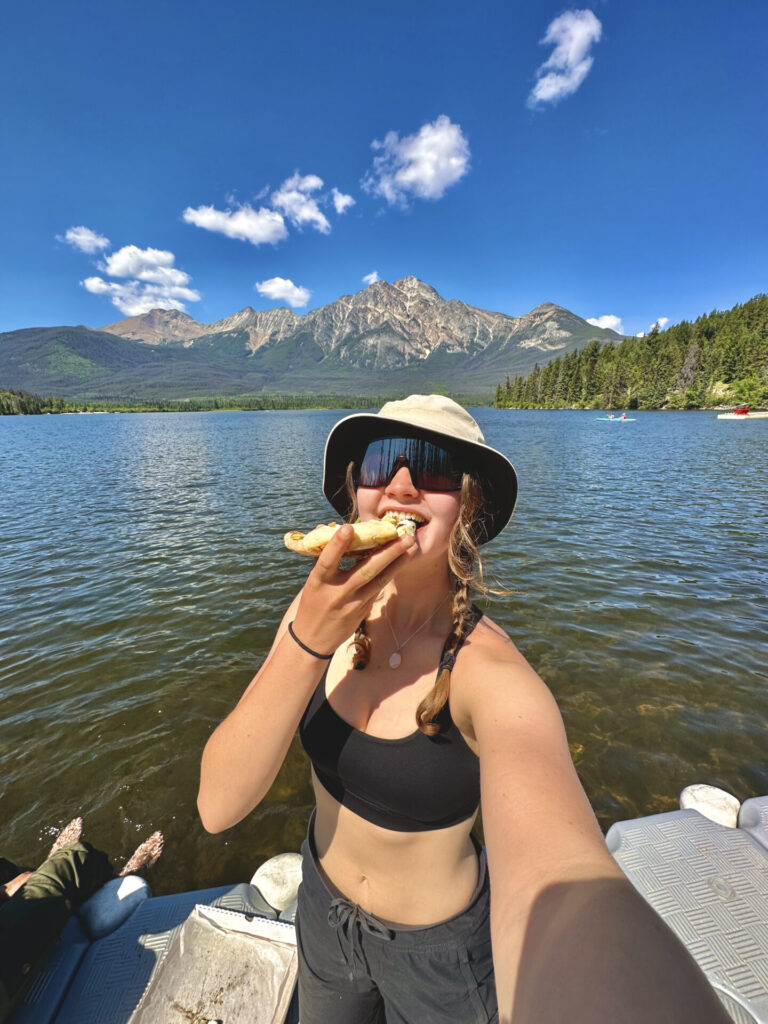
About the Author
HI, I’m Taylor – the voice behind The Holistic Backpacker.
After moving to Banff National Park in 2020 I became an outdoor adventure enthusiast and vowed to never stop exploring.
I now spend my days travelling the world, climbing mountains, and spending nights under the stars in the Canadian Rockies backcountry.
I created The Holistic Backpacker so I could share my adventures and help connect people like you with the same amazing experiences.


